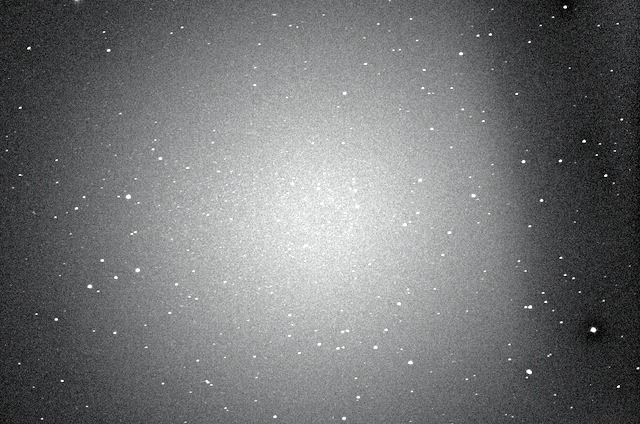
NGC55 Spiral Galaxy & Sculptor Dwarf Spheroidal Galaxy
Posted: 16 November 2011
On Friday, 11 November 2011, I did some POD maintenance for about 30 minutes. I refreshed the sealant at the bottom of some of the bay joins and I tightened up all the bolts on the bays and dome. This maintenance was in preparation for winter.
After a period of cloudy skies, I opened the observatory Tuesday, 16 November, at 1808 MST, temperature 69°F. Viewed Mercury at 1813 MST with the 26mm eyepiece. A partial phase was visible but due to its low altitude and an interferring tree limb, I could not determine its phase visually. I then viewed Venus, also low and in the tree. At 1824 MST, viewed Jupiter, low in the east, with the 26mm, 15mm, and 9.7mm eyepieces. Four moons were visible. Seeing was not good. I added the moon filter to the 9.7mm eyepiece, which improved the view of Jupiter.
At 1835 MST, I slewed the telescope to NGC55, a spiral galaxy, which was very low in the southeastern sky. It was faintly visible in the 26mm (77X) eyepiece. This is a very large (> 30') galaxy. From my location, it never gets very high in the sky, but after reading about it in a recent issue of Sky and Telescope magazine, I decided to try to image it with the D7000 DSLR. The same article also discussed the "Sculptor Dwarf Spheroidal Galaxy", a faint but large galaxy (also > 30'). I slewed the telescope to it, but it was too low to be seen visually. I went back to NGC55. At 1858 MST, I added the focal reducer; the view of NGC55 with the 26mm eyepiece was pretty nice, even though the galaxy was still low in the sky. It appeared to be a long thin galaxy visually. I then began setting up for D7000 DSLR prime focus + focal reducer imaging.
I did a focus test with the Bahtinov Mask on the star Fomalhaut. I then did some framing test images of NGC55. The galaxy was just barely visible in the camera viewfinder, but I wanted to find a guidestar. Eventually, I found one and did a 5 minute, ISO 6400, guided exposure. This is the (cropped) resulting image:

The galaxy's lopsided structure is visible, with its spiral arms extending more to the left of the nucleus than to the right.
I then slewed to the Sculptor Dwarf Spheroidal Galaxy and began searching for a guidestar. The galaxy was too faint to be seen in the viewfinder and I never located a guidestar. I decided to take some unguided exposures just to see if I could capture this large but faint galaxy, although it was low in my sky. I took 1, 2, and 3 minute, ISO 6400, unguided exposures. This is a heavily processed, 3 minute, uncropped, prime focus + focal reducer exposure, which shows the stars of the spheroidal-shaped galaxy. I was surprised that I actually captured the galaxy.

I ended imaging at 1951 MST. At 2000 MST, I returned to visually observing Jupiter, now higher in the sky. Seeing was much better now, although the humidity was getting higher. The best view was using the 9.7mm eyepiece + moon filter.
Due to the high humidity, I decided to close up.
Closed the observatory at 2020 MST, 49°F, humidity 62%.
I have ordered a JMI MicroFocuser for the 8" LX200-ACF from OPT. I will report on it after I install it.
Go to the previous report.
Return to the Cassiopeia Observatory Welcome Page.